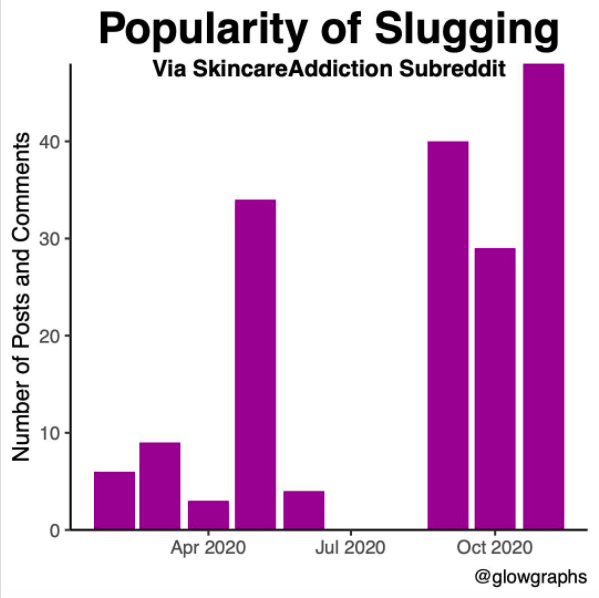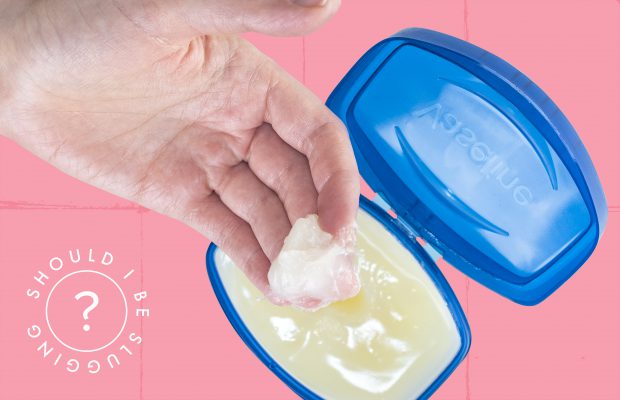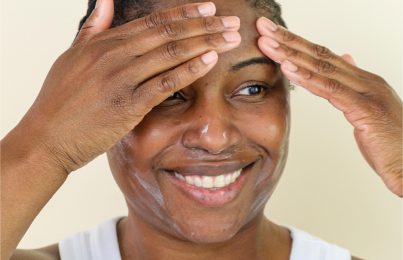Updated 3/12/24 Slugging is a skincare trend you might have seen on social media. The trend became popular on Reddit a few years back and is having a resurgence thanks to Instagram and TikTok. Needless to say, slugging has gone viral as a way to fix dry skin caused by a damaged moisture barrier. But does it really work? Is this the miracle we’ve all been looking for? And, maybe most importantly, is it safe for all skin types?
In this post, I’ll explain everything you need to know about fixing a damaged moisture barrier and give my thoughts on this new slugging skincare trend. Hint: it works, but there’s a catch.
What Is Slugging?

What Does the Moisture Barrier Have to Do With All This?
If you’ve read my blog before, chances are you’ve heard me talk about how important the moisture barrier is when it comes to skin health. Your skin’s barrier is made up of lipids that bind your skin cells together. An analogy that’s often used is that of a brick wall: if your skin cells are the bricks, the lipids are the mortar that binds everything together. When this mortar is intact, it keeps good things (moisture) in and bad things (irritants) out. However, if it develops cracks, moisture escapes and irritants enter.
When we talk about “barrier repair” in skincare, it usually refers to replenishing the lipid content of the stratum corneum (which is the outermost layer of the skin). In other words, it’s like adding more mortar to make sure the wall is sealed up nicely.
Can Slugging Fix a Damaged Moisture Barrier?
The answer is yes, but there are a few caveats. First, let me explain how Vaseline and other petrolatum products interact with your skin’s moisture barrier. When your barrier is weak because you don’t have enough lipids in your skin, Vaseline acts as a substitute for these lipids. Remember the brick-and-mortar analogy? Vaseline fills in the cracks in your skin’s “mortar” so that your barrier starts to act in a healthy way again. Vaseline is safe and chemically inert, meaning it won’t cause irritation (it’s even recommended for treating eczema in babies).
However, because Vaseline doesn’t contain any lipids of its own, it can’t actually replenish your skin’s lipids. This means that it isn’t a long-term solution to repairing barrier damage, but rather a band-aid to help you deal with the symptoms of a damaged barrier instead of addressing the underlying issue. That said, it acts as a safe way to temporarily keep damaged skin protected from water loss and irritation.
In short, if you have dry, damaged skin and you try the slugging skincare trend, you’ll probably see the results you’re looking for—smoother, softer, more moist skin. However, once you stop using Vaseline, the underlying issue of a damaged barrier is likely to still be there. While I think this is something you could do when your skin is in need of comfort, I believe there are more sophisticated products available that can address the underlying issue.
What Are Some Other Ways to Fix a Damaged Moisture Barrier?
-
Use niacinamide at approximately 4%. Reapply twice a day for at least 30 days. Continue applying at least a few times a week to maintain the results.
-
Use usnic acid (usnea). This is an extract found in tree moss. It can stimulate hydroxyceramide production in the granular layer of the epidermis. This ingredient may also help with wound healing. Apply twice daily for nine days. Continue use for ongoing results. (Just know it may not be listed as usnic acid on an ingredient label. Instead, it will likely be listed as sodium usnate or copper usnate.)
-
Use ceramides, essential fatty acids, and fatty acids. Use these twice a day for several days. Continue use for ongoing results. These can be found in Skin Recovery Balm.
-
Apply plant oils rich in fatty acids and omegas. When used twice daily, surface roughness is smoothed and the skin feels more comfortable. Both of these things are generally good signs of a strengthening moisture barrier. These ingredients can be found in Rest Day Masque.
- Use occlusive ingredients. Occlusive ingredients are those that form a protective barrier or ‘seal’ over the skin to keep hydration locked inside. This can be done with a thick coating of an occlusive mask or moisturizer and should be applied twice daily. (Slugging is considered to be an occlusion method, however, it’s not my go-to recommendation—but more on that later!)
Note: I mentioned how often such products and ingredients should be applied. That’s because it’s what’s ideal for barrier strengthening. However, you never want to interfere with your daily sunscreen, so please be mindful of this. Also, as for usnic acid, I haven’t seen any products for the face that use this ingredient, but I know from taking cosmetic chemistry courses that it has barrier benefits so I wanted to mention it.
Is Slugging Good for Blemish-Prone Skin?
In short, no. Unfortunately, barrier strengthening can be a dangerous game for those with blemish-prone skin. This is because almost all the methods, including slugging and the other methods mentioned above, can lead to comedogenicity if continued over a period of time. (I repeat: if continued over a period of time.)
“Comedogenicity” technically refers to how likely a product is to clog your pores. There is no real, industry-standard measurement for comedogenicity and an ingredient can act differently from person to person or formula to formula. This is why I don’t like to say any ingredients are 100 percent “bad” for blemish-prone skin. (This is the case with silicones, which have gotten a bad rap for being comedogenic when, in actuality, it’s not that straightforward. Read more about silicones.)
Comedogenicity depends on a lot of factors, including the percentage of the ingredient used, the presence of other comedogenic ingredients OR ingredients that enhance comedogenicity within the same formula, and the length and frequency of exposure. All of these things come together to determine whether or not a product is truly comedogenic. When it comes to slugging, you’re using a product with a very high concentration of petrolatum all over your face every day, so the chances of it leading to clogged pores are high.
Note: If you want to give slugging a try and your skin is prone to clogged pores, I would highly recommend that you don’t exfoliate the skin prior to applying petroleum jelly. Exfoliants remove surface dryness. This could “open” up the pores and allow for an increased chance of blockages. You could find yourself with bumps on the skin as soon as the next day.
What Products Are Best for Fixing Your Moisture Barrier If You Have Breakout-Prone Skin?
After years of searching for the perfect barrier repair product, I finally just made my own. Introducing Rest Day Masque, a deeply moisturizing mask that corrects dryness, irritation, and visible flaking by restoring skin’s barrier! Active ingredients (like retinol, retinoids, exfoliating acids, and benzoyl peroxide) can be great for really driving results, but sometimes our skin deserves a little extra pampering. I formulated this mask for the days when you need a break from heavy-hitting ingredients in order to spend a little extra time on your damaged barrier. The secret to this mask’s effectiveness lies in our Barrier3 technology. Using three powerful methods to revitalize the barrier, fatty acids, omega-rich plant oils, and occlusives form a protective seal on the skin, providing deep, long-lasting comfort.
I believe that plant oils can be safely used periodically and provide a great solution for barrier strengthening in oily skin. Breakout-prone skin (like Skin Types 1, 2, 3, & 4) can certainly experience a damaged barrier when topical drying agents are used. Unfortunately, many ingredients that fight blemishes can also lead to a damaged moisture barrier. They can interrupt the keratinocytes’ natural ability to produce intercellular lipids in the proper ratios, thus causing cells to shed and the skin to become ultra-sensitive and reactive.
This is why I not only wanted occlusives (the main ingredient in most barrier repair products), but also fatty acids and plant oils in this formula. These three ingredients work together much like a bandage and ointment, providing protection and rehabilitation. And as always, make sure you’re performing a patch test for compatibility prior to using a new skincare product, especially if you have extremely sensitive or allergic skin. While I formulated this product as a better alternative to barrier repair than slugging, you can rarely tell if a product is compatible with your skin until you try it.
The Bottom Line
The slugging skincare trend definitely works as a temporary measure for dry skin types. I know a lot of dermatologists recommend it, but I wouldn’t suggest permanently putting petrolatum in the place of moisturizer. However, it’s a safe, inexpensive ingredient that can give skin comfort. While it can temporarily relieve the symptoms of a damaged moisture barrier, it won’t fix the underlying issue, so I suggest using it as a stop-gap measure when your skin really needs some extra TLC.
I actually use Bedside Body Balm on my feet with socks in the winter. It works wonders, but it’s definitely not my go-to recommendation for the face. Aside from Rest Day Masque, I have two products that work really well for barrier repair. Both moisturizers, there’s the Phytolipid Comfort Cream for dry skin types and the Skin Recovery Lotion for oily, breakout-prone skin types. I mean, just look at what it did for my nephew’s skin!
When I Would Recommend Slugging
A good time to use Vaseline or petrolatum on your face is when you’re swimming in a chlorinated pool. Chlorine is super drying to the skin, especially if you use retinoids and your barrier is already compromised. Because Vaseline is a solid form of oil, it repels water. Therefore it will protect your skin from chlorine to prevent unnecessary dryness. Petrolatum also has a very low risk of causing an allergic reaction, which makes it great for protecting against irritation. I recommend washing it off as soon as you get out of the pool by using a cleansing lotion to break down the oil.
It could also be used to protect your face when you’re outside in a cold climate. But only use it at night. You don’t want it interfering with your sunscreen during the day. (I once went dog sledding up in Northern Maine and while I didn’t use this, this would be an example of when it could be helpful.)
Celebrity Esthetician & Skincare Expert
As an esthetician trained in cosmetic chemistry, Renée Rouleau has spent 35 years researching skin, educating her audience, and building an award-winning line of products. Her hands-on experience as an esthetician and trusted skin care expert has created a real-world solution — products that are formulated for nine different types of skin so your face will get exactly what it needs to look and feel its best. Trusted by celebrities, editors, bloggers, and skincare obsessives around the globe, her vast real-world knowledge and constant research are why Marie Claire calls her “the most passionate skin practitioner we know.”



